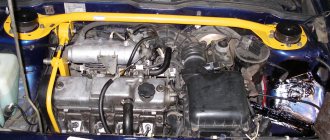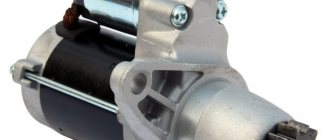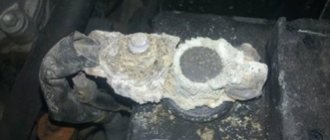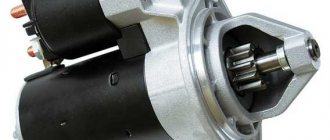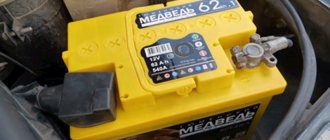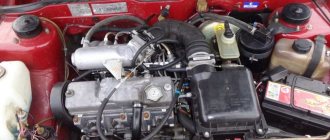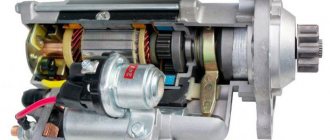Everything that had not been replaced was also gone: the modular unit, the spark plugs, and the crankshaft sensor. Does not help! Please tell me!
- There is no plus from the ignition switch on the VAZ 2109 - 13 answers
- VAZ 2108 starts and stalls after 1-2 seconds – 9 answers
- Why is there no spark and the fuel pump does not work, the check does not light up, VAZ 2115? – 8 answers
- Failure in acceleration mode VAZ Samara – 6 answers
- Why does the VAZ 2109 twitch? – 4 answers
Here you need to check everything along the chain, starting with whether power is supplied to the coil (babin) when the ignition is turned on, and further along the chain. The most ideal option is to go for diagnostics, you will save both money and time.
What to do if the car does not start? Almost every motorist has faced this question. In fact, everything is very simple. Air, spark and fuel should be checked. If you already know the cause of the problem, namely, there is no spark on the VAZ 2109 injector, then read this article.
So, the VAZ 2109 is equipped with a contactless ignition system.
No need to guess too much - you need to use the following devices
The first device is A3-1 - emergency ignition . You can use it in the rain or when driving through puddles (to warm up or dry the spark plugs) to check the electronic switch or when the hall sensor fails. In other words, emergency ignition is a substitute for a hall sensor, but with a speed limit of up to 90 km/h.
The second device – MD-1 – instant diagnostics . Used to check the functionality of the hall sensor, ignition coil and ignition switch. To begin with, it is better to use MD-1. We connect it instead of the switch and turn on the ignition, but we don’t start the car!
- if the “P” LED is on, the ignition switch and ignition relay are operational
- LED “K” is on – the ignition coil is working
- turn on the starter: if the “D” LED blinks, it means the hall sensor is working
What to do if there is no spark VAZ-2109 carburetor: reasons
The reasons why the spark disappears on a VAZ-2109 carburetor type car may be the following:
- faulty Hall sensor;
- the switch burned out;
- break in the ignition coil;
- high-voltage wires are worn out;
- the candles became unusable;
- The timing belt is worn.
From the very beginning, if the disappearance of the spark is detected, you should review all contacts and the condition of the electrical wiring. If you find oxidation on the connector, it must be cleaned with sandpaper and rechecked for the presence of a spark. High-voltage wires should be checked for integrity using a special device - a tester.
A breakdown in the ignition switch can be diagnosed using a standard automotive lamp. One of its contacts must be connected to the body body or carburetor engine 2109, and the second contact must be connected to wire “B+” from the ignition coil. If the light is on, this indicates that the ignition switch is working properly. In this case, you need to go to the ignition coil.
The serviceability of the Hall sensor can be checked using a voltmeter or, again, a light bulb. At the moment the distributor rotates, the filament in the light bulb should change the intensity of the glow.
The simplest way to check for proper ignition of carburetor VAZ-2109
If there is no spark in the car, you can find the reasons in another way. This technique does not require the use of a special device or tool. In this method, the entire ignition chain is tested, without taking into account the Hall sensor. To carry out this work, we need a small wire with insulated ends and a nail or paper clip.
First of all, we disconnect the high-voltage cable from the distributor. During checking, it must be positioned approximately 10 millimeters from the minus of the car. Next, turn on the ignition. Disconnect the connector from the Hall sensor and connect its end to the middle contact, to which the green wire is connected. We short the other end of our wire several times to ground. At the moment of short circuit, sparks should run between the ground and the end of the wire. If there is a spark in a carburetor VAZ-2109, we can conclude that the Hall sensor is faulty or there is no contact. Often, inside the distributor itself, the plate frays the wires or the connector simply becomes loose. In addition, there are cases when, when checking, we see the presence of a spark, but when connecting the wire to the spark plug caps, there is no spark. This indicates the need to replace the slider inside the distributor. Some carburetor-type VAZ-2109 are equipped with an ignition interlock circuit, which may also become unusable (or there is a malfunction in the switch).
Before performing the test, you need to prepare the following set of tools:
- figured and flat screwdrivers;
- insulated pliers;
- control with a wire or tester;
- spare spark plug.
To protect yourself from electric shock, you should wear dielectric gloves.
Verification process:
- We turn off the ignition, after which we check the high-voltage wires for breaks, and at the same time check for good contact in the connections with the distributor and the ignition coil.
- We carefully inspect the condition of the wires between the distributor and the switch, and also check the wires from the ignition coil to the switch.
- With the ignition switch on on a carburetor VAZ-2109, you need to check the presence of power in the system. To do this, take a test lamp, connect one end to ground, and the other to the “B+” contact of the coil. The glow of the control lamp indicates the presence of power.
- Using a rubber glove, disconnect the middle high-voltage wire from the distributor. We put a spark plug into its tip and touch the engine ground with the metal part. When cranking the starter, sparks should flow from the spark plug.
- Unscrew the screws of the distributor and remove its cover. We check for cracks and damage, and also check the condition of the coal. If the cover is damaged or cracked, it must be replaced.
- We inspect the condition of the slider in the distributor. Quite often it happens when there is no spark due to a breakdown of the interference suppression relay or breakdowns in the housing of the ground slider.
- We check the crankshaft by rotating the starter. If the slider is stationary, the reason for this is a broken timing belt or the drive itself is faulty.
- We check again for the presence of a spark.
- If once again there is no spark in a VAZ-2109 carburetor type car, you should check the high-voltage ignition wiring, as well as the spark plugs themselves. To do this, you must use a known good spark plug. If there is still no spark, change the high-voltage wire.
Possible reasons for absence
Most modern cars are equipped with an abundance of sensors. They make the car owner’s life easier and make repairs more difficult. In the electronics responsible for the operation of an injection engine, there are, of course, several sensors responsible for the spark formation process. However, the prerequisites for the absence of a spark (VAZ-2110, injector, 8 valves) usually occur in other components. There are a number of types of possible breakdowns. The first includes various problems in the car’s fuel system. This includes malfunctions when fuel is not allowed to enter the cylinders or the supply is malfunctioning.
If there is no spark (VAZ-2110, injector, 8 valves), then you will like it due to the fuel system. Often the pump relay or the submersible element itself burns out. The test is done by ear.
Next come the tasks related to the electronic part. These are some of the most common defects. With such breakdowns, an electronic discharge does not reach the spark plug. The mixture will not be set on fire. In the midst of global problems - a complete failure of the engine, a broken timing belt. These defects should not be dwelled upon carefully.
Reasons for the loss of spark in the VAZ 2109 carburetor
Experts identify the following as the main reasons why the spark disappears in the Nine carburetor:
- Switch malfunction.
- Incorrect functioning of the Hall sensor. Checking the serviceability of this element is carried out using a voltmeter or a lamp. The result, which allows us to confirm that the sensor is operating in normal mode, is a bright light, alternating with extinction, or a weak glow of the lamp when turning the distributor.
- Failure of the ignition coil, oxidation of power contacts (wires), breakdown of a high-voltage wire, contamination of the contact under the “slider”, etc.
- Malfunction of the ignition switch.
In addition, there are several other problems that are somehow related to the ignition system, and, consequently, to the formation of a spark. First of all, this is the formation of black deposits (carbon deposits) on the contacts of the spark plugs. This is not only unpleasant, but also a fairly common factor that contributes to a significant increase in fuel consumption.
The main reasons for the occurrence of such deposits are: incomplete closure of the carburetor air damper, an air filter requiring replacement, a low level of compression (air pressure) in the cylinders of the power unit, improper adjustment of valve system elements, etc. An insufficient level of engine oil can also have an indirect effect on the degree of soot formation.
The correctly set ignition timing also plays an important role in the process of generating a spark in the VAZ 2109 carburetor. We offer a simplified technology for setting it without the use of special equipment (strobe):
- We loosen the fastening of the distributor until it can rotate freely.
- We start the car’s power unit and wait until the maximum crankshaft speed is reached in the “idle” mode.
- Turn the distributor one notch in the negative direction.
- We turn off the engine.
- We fix the distributor.
- We screw in the screw for adjusting the “quality” of the combustible mixture until it stops.
- We unscrew the “quality” screw by 1/3 of a turn and increase the number of revolutions to 820-850 per minute.
In this section of our article, we offer instructions for adjusting the ignition system of the “nine” that are understandable and accessible to most car enthusiasts. It includes the following activities:
Set the engine crankshaft to top dead center (TDC). The cylinder block cover has three special marks corresponding to certain advance angle values:
– 100 (first);
-50 (second);
– 00 (third).
- Align the mark located on the crankshaft pulley with the mark on the block cover. The distributor body is fixed in the zero position of the octane corrector. The contacts must be in an open state (checked using a 12-volt lamp, the contacts of which are connected to the low voltage contact and the ground contact).
- If the contacts do not open (the lamp does not light up), perform the following manipulations:
– unscrew the lock nut securing the distributor plate;
– turn the distributor housing clockwise;
– slowly turning the housing in the opposite direction until the light comes on.
While holding the distributor body in this position, tighten the lock nut of the fastening plate.
The principle of operation is clear. All malfunctions of the VAZ 2109 ignition system are associated with the failure of one of the above elements. If there is no spark on the VAZ 2109 carburetor, it means there is a malfunction:
- switch;
- Hall sensor;
- timing belt;
- ignition coils;
- ignition switch contact groups;
- distributor cover contacts;
- candles (“drenched”, burnt);
- circuit wiring.
If the commutator is faulty, then the voltage value to the coil is not converted. A failed Hall sensor does not supply current to the switch. If the timing belt breaks, the operation of the system is disrupted and EMF is not generated. A broken coil stops the chain moving on itself, the distributor contact does not receive voltage. Damaged distributor cover contacts prevent voltage from being applied to the spark plug.
The spark plug electrodes may not produce a spark due to carbon deposits or moisture on them. It happens that the culprit is the first element of the circuit: the ignition switch. A breakdown in its contact group does not start the starter. It is also possible that a banal damage to the wiring has occurred, causing the connection of the elements to disappear.
Stage one
Usually the symptoms of difficulty are the following: the starter rotates regularly in its own standard mode, but the engine does not want to start. One of the most possible circumstances is a fuel pump that does not start. When on injection “tens” it is submersible and is located directly in the tank.
There is an option to check the element by the presence of operating sound. Turn on the ignition - there should be a rumble in the area of the rear seats. He is absent from time to time. In our version, you should check the fuses. The VAZ-2110 is a fuel-injected car, and the fuse box is located on the side of the center console of the unfamiliar front passenger. You need to unscrew the fasteners, then remove the cover, check the fuses for functionality and change them as necessary. In this case, the elements are 100% serviceable, then you need to check whether the relay will turn on, both the main one and the fuel pump. Of course, you can feel the moment of switching on with your finger. A corresponding click will also be heard.
Bringing the car back to life
As for why a spark disappears, everything is probably very clear. Now, it would not be amiss to consider the order of her return. The reality is that in most cases, getting the spark back is a simple matter and just involves carefully checking the broken car. To be more precise, to normalize sparking it is required:
- Firstly, check the spark on the injector using the method described above, make sure that it has disappeared, and, at least indirectly, try to determine the cause of the malfunction;
- Next, it is enough to assess the current circumstances and act based on them. As typical situations, we suggest considering solutions to the following problems:
- the spark plug is wet, the presence and strength of the spark are unimportant, the carbon deposits are correct (brick color) - wipe the part and screw it back in;
- the spark plug is wet (not always) and the carbon deposits are incorrect (white or black) - clean, dry the part and try to start the engine, if there is no result, change the spark plug and deal with problems in the fuel system (cleaning the injector, checking the ECU, etc.);
- the spark plug is wet, there is no spark at all, the color of the soot is not important - we try to change the part, if there is no result, we check the ignition system and the operation of the injector.
In principle, in theory there are no particular difficulties in repairs of this kind. Despite this, it often causes difficulties in implementation for inexperienced motorists. To solve these, you need to act in the order described above, but if something doesn’t work out, it’s better to turn to professionals at a service station. This approach to repairs will not only save time, but also guarantee trouble-free operation of the car in the future.
Perhaps this concludes the most important information on today’s issue. We hope that the material presented was useful to you and provided answers to your questions. Good luck in operating and maintaining your car!
Stage two
If there is no spark on a VAZ-2110 (injector, 8 valves), then spark plugs are often the cause. What, they are inspected if the fuel pump is working. It is best to use a spark gap for testing. If the current is distributed over two spark plugs, then there will certainly be a breakdown to ground.
You can find out why there is no spark on the VAZ-2110 (injector, 8 valves) using a faulty controller. It is also possible that the wires from the controller to the ignition coil will break. If spark on all coils, you should check the power supply. Typical specifications are up to 200 kΩ.
High voltage wires
Next you need to visually check the high voltage wiring. There should be no visible damage or disruption of the insulating layer. If the wiring is in good condition, you should check the wiring to the spark plugs.
To do this, you need to remove the tip from the spark plug wire, bring it to a place on the body without paint and start the car. When the starter rotates, a bright spark with a bluish tint should appear. If this does not happen, you should check the ignition coil.
At the same time, the spark plugs do not fail. If there is a spark in the spark plug wiring, it is possible to check any of the glow plugs. To do this, you need to unscrew the suspicious spark plug from the block and put the spark plug wire on it. Next, you should touch the place on the body without paint with a metal part and, by rotating the starter, determine whether there is a spark or not.
Replacement of spark plugs must occur in a timely manner, in accordance with the maintenance of your car model. For VAZ-2115 - approximately every 20 thousand kilometers.
Ignition module and coil
There is an option to check the error codes that are in the car’s memory. On the contrary, the ECU does not have a diagnostic function; a working module must be installed in advance.
It is likely that the wire to the ignition coil has broken or there are breaks in its winding. If a VAZ-2110 car does not have a spark (injector, 8 valves) on 2 wires, then the cause is a non-working ignition coil, also called a controller. In two cases, of course, there is a possibility of high-voltage wires breaking. The myth option is worth checking first. Look at the resistance level.
If there is no electronic discharge for some reason, then the element must be replaced. The system has an ignition module. Therefore, a useful operation would be to check the “minus”.
Causes of sparking problems
If there is no spark on the injector, and not, for example, on a carburetor or gear motor, you will have to try to identify the reasons for its loss. This is due to the fact that there are slightly more factors influencing spark formation in injection systems and they look more multifaceted. If we summarize the general list of possible causes of the problem, then it is worth highlighting the following most common ones:
- The spark plug or spark plugs are flooded with fuel - there is either no spark or very weak, the spark plugs themselves are wet;
- The spark plug or spark plugs are faulty - there is no spark at all, deposits on the contacts are usually black or white;
- The crankshaft sensor, ignition module, ignition coil, switch or distributor is faulty - there is no spark at all, the engine shows no signs of “life”, the injector does not work correctly;
- High-voltage wires have broken through or there has been a loss of contacts - one or two spark plugs do not work, the rest are fully operational;
- The injector electronics (ECU or wires) are faulty - the unit does not work correctly, there is no spark at all spark plugs;
- The injector nozzles are clogged - there is no spark at the spark plugs of specific cylinders, the injector is not working correctly.
Please note that for a complete and most accurate diagnosis, it is necessary to carry out several procedures at once:
- Naturally, check for a spark;
- Assess for the presence of the symptoms described above;
- Check for relevant errors on the dashboard or on-board computer screen;
- Check the potentially faulty unit (disassembly, cleaning, diagnostics with a multimeter, etc.).
Possible errors in VAZ injectors
Codes, of course, indicate defects in all parts and components in the car. In most cases this is due to sensors. Temperature sensors suffer in particular - they overheat. Car owners also complain about the injectors. Problems arise due to breaks in the circuit. Once completed, they do not have the basis to work properly. This also includes the popular breakdown on the VAZ-2110 - no spark. The 8 valve injector cannot start normally due to this.
Distributor
When looking for problems with the distributor, you need to take a close look at the inside of the cap. If there is damage, it should be replaced. If there are no problem areas, wash with gasoline. You can check the central contact of the distributor by moving it slightly to the side.
The integrity of the rotor insulation is easily checked by placing the central high-voltage wire at a distance of 5 mm from the rotor electrode and closing the breaker contacts with the ignition on. Sparks appearing in the gap mean that the rotor is not working and needs to be replaced.
Other faults
If the starter does not spin, the spark disappears between the ignition switch and this element. This often happens when the battery is discharged or faulty. When tested, a regular battery indicates approximately 11.8 V. A faulty ignition cylinder will immediately appear just when the driver inserts and turns the key. If turning the key is very easy or difficult, you need to change the lock. The starter relay or the accounting ignition system is also one of the likely circumstances of the lack of a spark. But there is no way to check these nodes without the help of others. The “retractor” device may be stuck in the starter. In this case, the spark is lost along the way. Experienced car owners hit the starter with a key, or in other words, with a hammer, to return the spark. However, this is only relevant at the site of the breakdown.
What to do if there is no spark in a VAZ-2110 car? Check the starter in the garage using a battery. If you press the body of the device to the “minus” of the battery, and stretch the “plus” wire to the “retractor”, then the device comes to life. Often the spark may disappear where power is supplied to the starter. It is advisable to inspect this circuit with a multimeter. You can't do it alone - the assistant works with the key while taking measurements.
VAZ-2109 does not start - what to do?
In general, diagnosing malfunctions of the controller (computer) and control system sensors, as well as the VAZ-2109 injector itself, is not much different from similar work for other cars. But due to the peculiarities of the “nine” control system, experienced owners of this car recommend the following solutions.
Most often, the injection “nine” does not start in winter. In this case, it is advisable to warm up and even recharge the battery - perhaps due to loss of capacity due to low temperature, it is not able to spin the engine shaft well.
Another “folk” method that helps is supplying air to the engine filter through a hairdryer. At the same time, heated air will flow into the cylinders. Many people claim that the VAZ starts right away.
Another possible reason: as a result of prolonged unsuccessful attempts to start, the spark plugs were filled with gasoline. In this case, it is recommended to try to start the car with the gas pedal pressed all the way to the floor - the spark plugs should dry out and the car will start. If this does not help, then unscrew the spark plugs and check for the presence of a spark. If it is not there, then either the spark plugs or the ignition system are faulty.
We set the ignition on a VAZ-21099 carburetor without a strobe
To set the ignition in the absence of a strobe, you must first loosen the distributor fastening so that it can be turned freely. At the same time, it should not dangle. After this, we start the engine and spin it at idle to maximum speed. After this, turn the distributor to minus one notch and turn off the engine. We tighten the fastening screws and proceed to adjusting the carburetor.
First, we tighten the fuel mixture quality control screw all the way, and then rotate it in the opposite direction by one-third of a full turn, which will correspond to an idle speed of 800 + 50 rpm.
How a spark is formed on a candle
By turning the key in the ignition, you turn the starter. Its function is to engage the gear with the flywheel to transmit torque to the flywheel. As soon as the parts are engaged, the moment is transferred - the key returns to its place. And during this time, while the key was turned, a number of processes should occur, as a result of which a spark appears on the candles.
The flywheel itself is mounted on the crankshaft and rotates it. From the crankshaft through the timing belt, rotational motion is transmitted to the camshaft. Simultaneously with the camshaft and at the same frequency, the shaft on which the distributor slider (ignition distributor) is located rotates. The cylindrical screen rotates and an electromagnetic field (EMF) is generated, the voltage value of which is read by a Hall sensor. Next, the switch comes into operation. This device converts the voltage to the required value and transmits it to the primary winding of the ignition coil.
An electromotive force is generated inside the coil and exits through the central electrode. From here the pulse is supplied to the central wire of the distributor, to which 4 spark plugs are connected. The distributor rotates, making contact with each of the spark plugs in turn. The spark plugs are screwed into the cylinder head, their electrodes are located in the combustion chamber.
As a result of a short circuit on the spark plugs, a voltage of 10–15 kV is achieved. This is enough for a spark to occur between the central and side electrodes of the spark plug.
Source
Reason #5 – Burnout of transistors in the ECU
The lack of a spark can also be explained by broken transistors in the VAZ electronic control unit. To detect faulty elements, you will need to dismantle the controller and also remove the protective cover.
To check the functionality of the transistors, you will need to use a multimeter. The device is put into dialing mode, then both contacts of the transistor, as well as ground, are checked. When a short circuit is detected, the multimeter will emit a corresponding squeak, and the broken transistor must be replaced with a similar serviceable element.
Source

